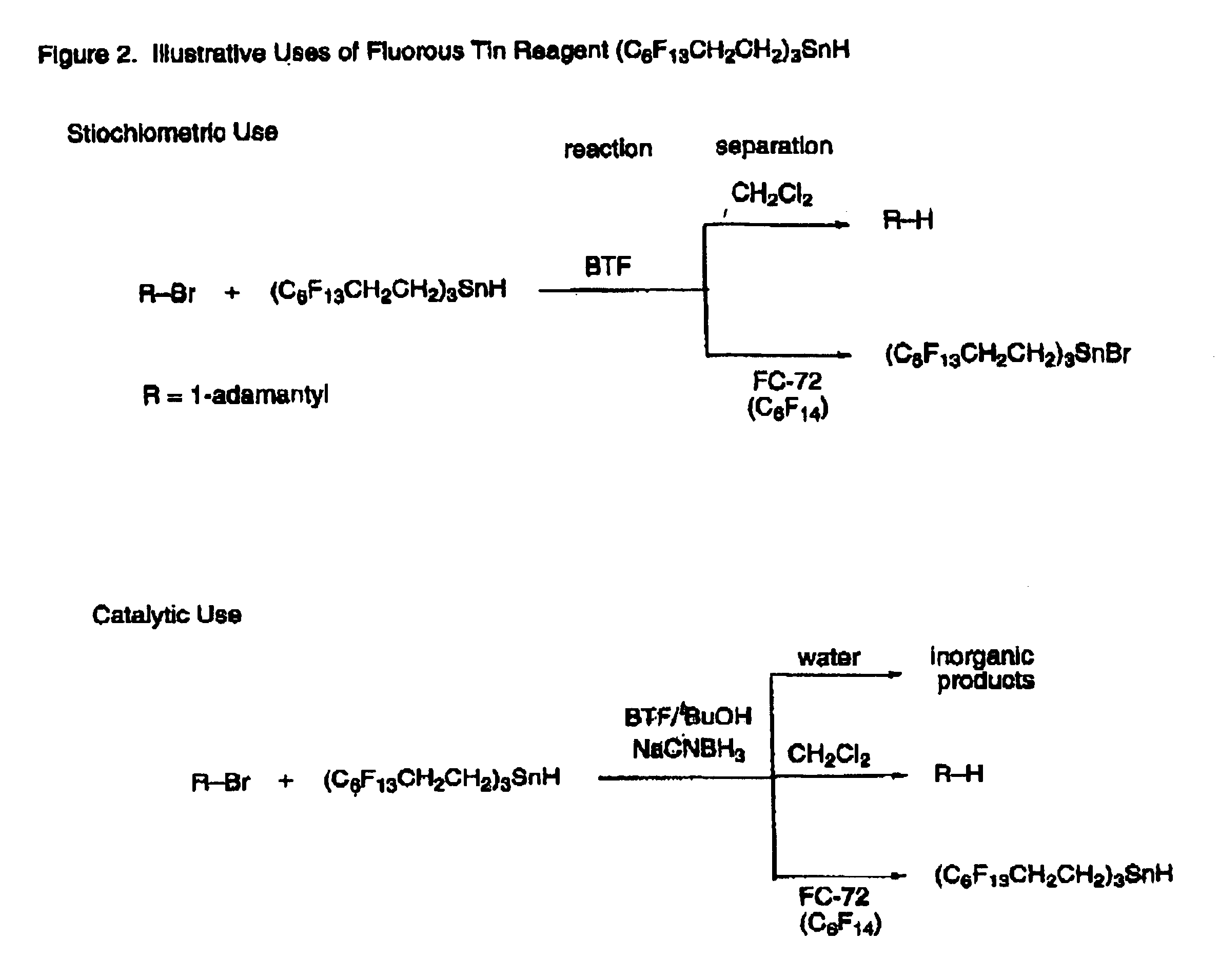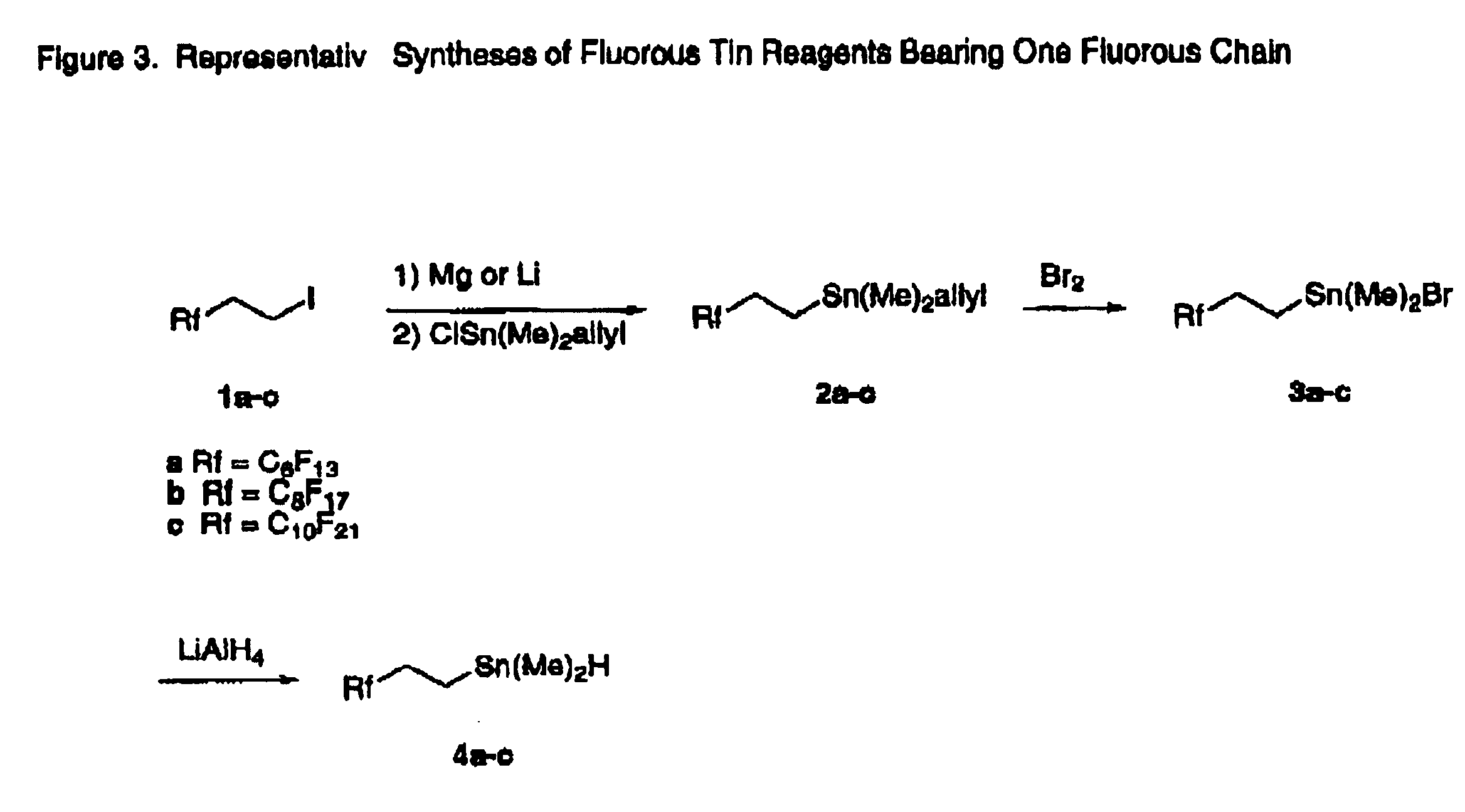Fluorous tin compounds an methods of using fluorous tin compounds
a technology of fluorous tin and compounds, which is applied in the field of fluorous tin compounds, can solve the problems of difficult separation of non-tin containing organic products from the remaining tin compounds in the reaction mixture, tedious and time-consuming separation of desired products from any added reactants, reagents or catalysts, etc., and achieves the scope of application in chemical reactions of the fluorous tin reaction components of the present invention dramatically increased, and the molecular weigh
- Summary
- Abstract
- Description
- Claims
- Application Information
AI Technical Summary
Benefits of technology
Problems solved by technology
Method used
Image
Examples
example 1a
Allyl-dimethyl-(3,3,4,4,5,5,6,6,7,7,8,8,8-tridecafluorooctyl)stannane (2a). Freshly prepared allyldimethyltin chloride (2.86 g, 12.7 mmol) was added dropwise to the Grignard reagent of C6F13CH2CH2MgI, which was prepared from C6F13CH2CH2I (6.0 g, 12.7 mmol) and magnesium powder (0.37 g, 15.2 mmol). The reaction mixture was refluxed overnight (16 h) before quenching with 1N HCl. The crude product was purified by vacuum distillation (112° C. / water pump) to give pure 2a as a colorless oil (3.20 g, 35%). 1H NMR (CDCl3) δ 5.95-5.86 (m, 1H), 4.85-4.80 (dd, J=16.8, 1.4 Hz, 1H), 4.73-4.69 (dd, J=11.8, 1.8 Hz, 1H), 2.30-2.12 (m, 2H), 1.83 (d, J=8.5 Hz, 2H), 1.00-0.92 (m, 2H), 0.15 (s, JSn-H=26.3 Hz, 6H); 13C NMR (CDCl3) δ 136.8, 121.8-107.2 (m), 27.9 (t), 16.9, −1.8, −12.2; 19F NMR (CDCl3) δ−81.3 (3F), −117.2 (2F), −122.5 (2F), −123.4 (2F), −123.9 (2F), −126.7 (2F); 119Sn NMR (C6D6): δ−1.4; HRMS: calc. 496.9597 (M+-Me), found: 496.9583. IR (thin film): 1626 cm−1.
example 1b
Allyl-dimethyl-(3,3,4,4,5,5,6,6,7,7,8,8,9,9,10,10,10-heptadecafluorodecyl)stannane (2b). To a solution of C8CF17CH2CH2I (3.34 g, 5.82 mmol) in dry ether (50 mL) and dry hexanes (50 mL) at −78° C. was added tBuLi (7.5 mL, 1.7 M in pentane). After stirring at −78° C. for 30 min, freshly prepared allyldimethyl tinchloride (1.46 g, 6.47 mmol) was added slowly. The reaction mixture was stirred at −78° C. for 1 h and allowed to warm to room temperature in two to three hours before quenching with water. After extraction between ether and water, the ether phase was dried over MgSO4. The crude product was purified by flash chromatography with n-heptane to give 2b as a clear oil (2.15 g, 58%). 1H NMR (CDCl3) δ 5.95-5.86 (m, 1H), 4.85-4.69 (dd, J=17.0, 1.1 Hz, 2H), 2.30-2.12 (m, 2H), 1.83 (d, J=8.7 Hz, 2H), 1.00-0.92 (m, 2H), 0.15 (s, JSn-H=26.1 Hz, 6H); 13C NMR (CDCl3) δ 136.8, 119.2-108.2 (m), 28.0 (t), 17.1, −1.6; 19F NMR (CDCl3) δ−81.0 (3F), −116.9 (2F), −122.2 (6F), −122.3 (2F), −123.6 (2...
example 1c
Allyl-dimethyl-(3,3,4,4,5,5,6,6,7,7,8,8,9,9,10,10,11,11,12,12,12-heneicosafluorododecyl)stannane (2c). This compound was prepared with the same procedure as for 2b. Yield: 83% (clear oil). 1H NMR (CDCl3) δ 5.98-5.83 (m, 1H), 4.87-4.80 (dd, J=16.6, 1 Hz, 1H), 4.74-4.70 (dd, J=9.6, 1 Hz, 1H), 2.30-2.12 (m, 2H), 1.83 (d, J=8.6 Hz, 2H), 1.00-0.94 (m, 2H), 0.15 (s, JSn-H=26.1 Hz, 6H); 13C NMR (CDCl3) δ 136.8, 121.9-106.9 (m), 28.0 (t), 17.1, −1.6, −11.8; 19F NMR (CDCl3) δ−80.9 (3F), −116.9 (2F), −122.0 (10F), −122.9 (2F). −123.6 (2F), −126.3 (2F); 119Sn NMR (C6D6) δ−0.47; HRMS: Calcd. 722.9626 (M+-Me), found: 722.9623; IR (thin film): 1626 cm−1.
PUM
| Property | Measurement | Unit |
|---|---|---|
| solubility | aaaaa | aaaaa |
| molecular weight | aaaaa | aaaaa |
| soluble | aaaaa | aaaaa |
Abstract
Description
Claims
Application Information
 Login to View More
Login to View More - R&D
- Intellectual Property
- Life Sciences
- Materials
- Tech Scout
- Unparalleled Data Quality
- Higher Quality Content
- 60% Fewer Hallucinations
Browse by: Latest US Patents, China's latest patents, Technical Efficacy Thesaurus, Application Domain, Technology Topic, Popular Technical Reports.
© 2025 PatSnap. All rights reserved.Legal|Privacy policy|Modern Slavery Act Transparency Statement|Sitemap|About US| Contact US: help@patsnap.com



